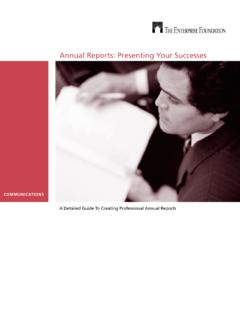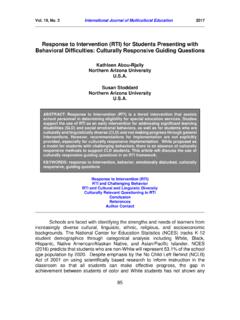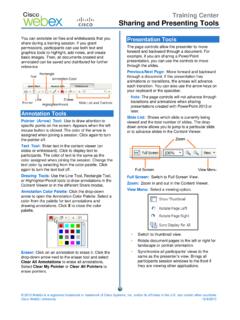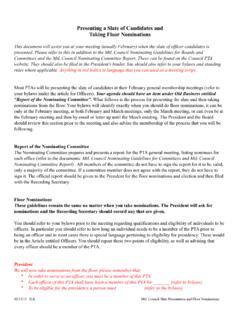Transcription of Presenting survey results – Report writing
1 Presenting survey results Report writing Introduction Report writing is one of the most important components in the survey research cycle. survey findings need to be presented in a way that is readable and technically acceptable. Good writing is essential to ensure the importance and usefulness of the findings are not lost. This paper has been designed to provide guidance on how to write a Report so that the information is easy to understand, and so that the findings are not unintentionally misrepresented. The overall aim of the written Report is to communicate the survey findings. A Report provides a formal record of the survey research, and can provide a foundation for future research efforts. The written Report is often the only aspect of a survey research project that gets exposure. Consequently, the overall quality of a project is often judged on how well the Report is written and presented.
2 A good Report should: meet the brief and address the objectives present clear findings with strong conclusions (and recommendations if appropriate) be accurate and free of errors use tables, graphs and text appropriately be written in a way that will convey the results without overwhelming or boring the reader. This paper provides hints and tips on writing for research reports. Tables and graphs are also important components of a research Report . Information on Presenting data in tables and graphs can be found in the following companion papers produced by the Queensland Government Statistician s Office (QGSO): Presenting statistical information Graphs Presenting statistical information Tables Please note: the data contained in this paper are fictitious and are provided as examples only. Key terms The following statistical terms have been used in this paper and a brief definition is given for each.
3 For a fuller definition and further information about these and other such terms, please see Assessing survey data available on the QGSO website. Term Brief definition Confidence interval provides a range of values around the estimate, within which the true value can be expected to fall. The smaller the confidence interval is for a particular estimate, the more precise the estimate is. Relative standard error (RSE) a measure of accuracy of a survey estimate calculated by dividing the standard error by the estimate obtained often expressed as a percentage. Standard error a statistical term for measuring the accuracy with which a statistic taken from a sample represents an entire population. The smaller the standard error, the more representative the sample will be. Statistical significance a statement about the likelihood of findings being due to chance.
4 Presenting survey results Report writing 2 Report structure Most survey research reports follow a fairly standard structure with the following inclusions: Front page This is the window into the Report . Choose a short, relevant and interesting title. Include the date of publication/release, author and contact details such as address and phone number. Copyright and/or licence information should also be included, if Report is published. (see ) Table of contents This allows the reader to gain an overview of what is contained in the document, and quickly locate sections they may wish to read. Executive summary The executive summary should summarise all the main points discussed in the Report , including the methods, key results (preferably grouped by objectives or themes) and conclusions/recommendations.
5 The executive summary should ideally be limited to one or two pages. It should highlight the key messages that the decision makers will need to know, but not necessarily every result that is of statistical significance. The summary should be the most polished part of the document, as it will almost certainly be the part that is most read. Background and objectives This section provides the reader with context to understand the background to the survey , and the reasons for which the research has been conducted. It would typically also include information on how the research results are intended to be used. The amount of detail provided in this section will depend on the nature and complexity of the survey . survey method This part discusses who has been included in the survey and why, the source material or list from which respondents from the target population were drawn (the list may include individuals, households or institutions), how many people were surveyed, how they were contacted, and the method of data collection.
6 Individual sub-sections may be required to adequately cover all the details, depending on the complexity of the survey . Highly technical information regarding survey method and operations can be included in an appendix. survey results This is the main body of the Report , containing details of the survey results . Consider structuring this section according to the objectives of the project or themes, rather than by question order. Refer back to the research objectives and ensure they are all covered. The information contained in this section shows the key results from the survey . It does not need to include every possible breakdown of the data. Rather, it should highlight results that are of both statistical and practical significance. All sources of data in the findings should be referenced so it is clear where they have come from, and so their credibility can be assessed.
7 Any dubious content should be put into an appendix of supporting material, rather than included in this section. Appendices The survey questionnaire should always be included in the appendices. The appendices may also contain detailed technical information about survey methodology, collection processes, data processing and analysis techniques. Appendices commonly contain a glossary of technical terms and a list of figures and graphs. Alternatively, a glossary and list of figures and graphs can be provided at the front of the document, to introduce and explain technical terms the reader will encounter. Presenting survey results Report writing 3 Style Agencies and organisations will have their own preferences in terms of style. Regardless of specific style preferences, the Report should be consistent in application of the following components: font spacing abbreviations dot points formatting of headings and subheadings page numbering quotes and references.
8 writing for reports The purpose of Report writing is to communicate the findings of the research. The Report should tell the whole story what the objectives of the research were, how the data were collected, what the data say and what the implications of the findings are. Every individual has their own style of writing . While there is no single right style for Report writing , there are some basic principles that should be followed. Plain English Report writing often involves communicating abstract and potentially difficult concepts (such as those involved in statistical modelling and analysis). Careful use of language is especially important in this context. Poor quality writing makes it difficult for the reader to work out the intended meaning, and can lead to the results being misinterpreted. Use of plain English helps to ensure the Report is easily understood by the target audience.
9 Plain English emphasizes clarity, brevity, and the avoidance of jargon and technical language. While the use of technical language is appropriate for some audiences, it should never be assumed that all readers will understand all terms. If technical terms are included, they should each be defined. Consider the audience The information needs to be appropriately conveyed to the key decision makers. There is a high probability that most people who will read the Report are not trained statisticians. Assume that readers will not have a strong grasp of statistical concepts. Provide definitions for terms such as statistical significance, confidence interval etc. in layman s terms. Use clear simple language and short sentences Write in a way that will be easily understood by the target audience. Use clear, unambiguous language that is appropriate to their reading skills and knowledge.
10 Try to include just one complete, clearly presented point per sentence. If connecting more than one point in a sentence, make sure they are directly and clearly linked. Readers should feel as though they're getting good value in return for the number of words they're required to read. Don t use three words when two will do use precise word choices, and use an online thesaurus to help find the most appropriate word if necessary. Also work to eliminate unnecessary words. For example, much of the time the word that is totally unnecessary. When in doubt, leave it out. Don t include clich s, colloquialisms, vogue words/expressions or needless jargon. Use dot points where appropriate. They can be an effective way of summarising a large amount of information. Correct grammar and punctuation It s very important to ensure that grammar, spelling and punctuation are correct.








